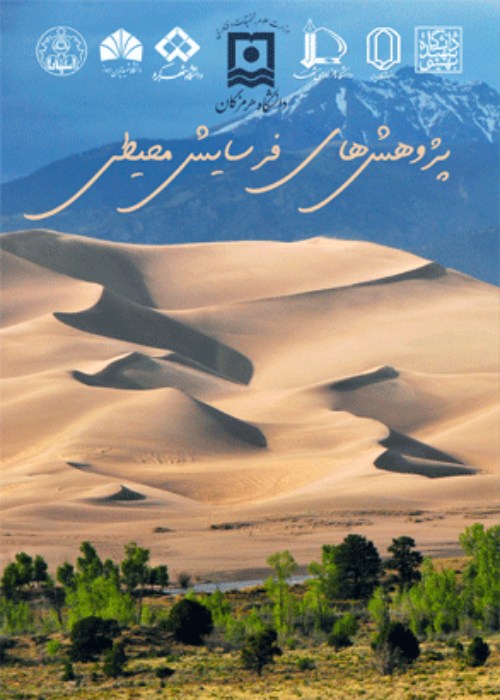Investigating the Role of Lateral and River Bed Erosion on River Channel Morphology: Case Study of the Main Channel of Kahoo Alluvial Fan of Mashhad
Changes in the river duct, erosion and marginal deposition are natural processes of alluvial rivers; on the other hand, the development of human activities, such as sand making, construction along the river, and the protection of coastal lines and land use changes have led to a change in the dynamics and rivers' morphology (Grigory, 2006). Human activities cause more pressure on the river and the destruction of the riperin area (the area covered by the plant along the river) and, consequently, lead to the change of the river ecosystem (Lee, 2005). Therefore, lateral erosion and river channel changes are among the environmental, economic and social problem that often cause irreparable damage to residents and riverside facilities (Jav, 2008). Lateral erosion is one of the major causes of uncontaminated water resources and increasing sediment load in many rivers. Increased erosion not only increases the sediment load but also causes the river's instability and changes the flow type and channel pattern (Hossein Zadeh et al., 2017).
The total area of Kahoo Basin is 193.40 km2 and the length of its river is 41.41 km. Based on the geological maps, Kahoo Basin is divided into two parts of the mountain and alluvial fan. For the study of river morphology data and physiography of the basin, topography maps of 1/100000 (Ministry of Transportation) and 1/500000 (Golmakan, Geographical Organization of the Army, 1894) have been used. By using Landsat satellite images base maps are created and other indices and plans derived from field observations are obtained. Also, graphs and maps are mapped using Arc GIS software. The main objective of this research was to investigate the role of lateral erosion in the main channel bed of Kahoo alluvial fan. For this purpose, in the main channel, eighty profiles were sampled from proximal to distal of the alluvial fan.
The morphology of the main channel indicates a braided-type in most sectors at the beginning, which only in three intervals around the Devin and Shahniyaz villages changes to anastomosing-type. The estimated length is 1.56 Km. Also, the width of the main channel shows that the river's width is decreasing downward. To study the river bed width variations, using the ARC GIS software, the main channel of Kahoo alluvial fan was divided into 4 groups of less than 10 meters, 10-25, 50- 25, and 50-100 meters. Studies show that the maximum river route is 12.8 km in a transverse class less than 10 meters. The transversal classes are 10-25, 41.4 km, 25-50, 7-10, and 50-100 km long, 0.5 km long. The widest part of the river bed is 19/79 meters wide near the Hashem Abad village and the narrowest part of the bed is about one-meter-wide near the village of Devine at the end of the study period. In general, the average width of the river studied is less than 10 meters.
Sedimentation and erosion are the two main processes in the evolution of Quaternary massive alluvial fans, the function of which can be a function of technical controlling factors, climate, base surface and bedrock composition, and index of flood volume and amount of sediment entering the alluvial fan (Naipal et al., 2020). Kahoo alluvial fan is located in the northwest of Khorasan Razavi province in the Mashhad plain and in the Kashfarud catchment area, which is one of the large basins of Qaraqoom. This study studied the plain section. From the geomorphological point of view, the canal of this river, except for the short distance, which is anastomosing, is more than the cut type, so erosive factors will play a much greater role in controlling the canal (Yang et al. 2007). The results of canal erosion were examined in two parts of the side and the bed.
The study of lateral erosion shows that the average depth of terraces is between two to five meters and the intensity of erosion is furrow and moat type, so the river class is H2T3. It should be noted that it is more visible on the left bank of the H3T1 class and on the right bank of the H3T4 class, which indicates more erosion at the left bank arches, and the river will probably lean to the left. Accordingly, this river can be considered asymmetric in terms of lateral erosion (Gopmbrtva et al., 2020).
The results of bed erosion study indicate that in most sections, the cross-sectional dimensions have not reached the final equilibrium and the depth and slope of the river have less changes than the river width, which shows that bed erosion is less than wall erosion. Therefore, the riverbed can be considered close to equilibrium in most places (Lacey 1959).
Field observations also confirm that lateral erosion, especially in the outer part of the river arch, is more. Also, based on the satellite image of Kahoo alluvial fan and the changes of the main channel, especially in its middle and ending sections, the migration of the channel to the left can be seen. Therefore, further erosion of the left wall can be considered as the most important factor in the morphology of the main channel of this alluvial fan today, which has caused changes in slope, width, etc.
- حق عضویت دریافتی صرف حمایت از نشریات عضو و نگهداری، تکمیل و توسعه مگیران میشود.
- پرداخت حق اشتراک و دانلود مقالات اجازه بازنشر آن در سایر رسانههای چاپی و دیجیتال را به کاربر نمیدهد.


